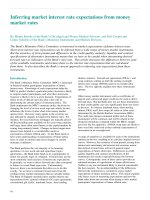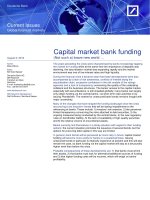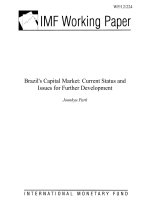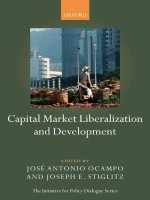R16 capital market expectations
Bạn đang xem bản rút gọn của tài liệu. Xem và tải ngay bản đầy đủ của tài liệu tại đây (1.23 MB, 65 trang )
Reading 16
Capital Market Expectations
www.irfanullah.co
Graphs, charts, tables, examples, and figures are copyright 2014, CFA Institute. Reproduced
and republished with permission from CFA Institute. All rights reserved.
Introduction
• Capital Market Expectations: investor’s expectations concerning
the risk and return prospects of asset classes
• Investor can decide how he defines assets classes
• Macro Expectations vs. Micro Expectations
Major Sections in this Reading:
–
–
–
Framework and Challenges
Tools for Formulating Capital Market Expectations
Economic Analysis
www.irfanullah.co
2
2. Organizing the Task: Framework and Challenges
1.
Specify final set of expectations that are needed
2.
Research the historical record
3.
Specify required models and information requirement
4.
Determine best sources for information needs
5.
Interpret current investment environment
6.
Provide set of expectations that are needed, documenting conclusions
7.
Monitor, feedback
www.irfanullah.co
3
Step 1: Specify the final set of expectations that are needed,
including the time horizon to which they apply
• Understand specific objectives of analysis
• Set boundaries focus on what is relevant
• Write the questions which need to be answered
www.irfanullah.co
4
www.irfanullah.co
5
www.irfanullah.co
6
Step 2: Research Historical Trend
• Most forecasts have connection to the past
• Understand factors which drive returns
• Can collect data based on geographic region, assets classes, sub-asset
classes…
www.irfanullah.co
7
Step 3: Specify methods and/or models that will be used and their
information requirement
• Consider time-horizon when selecting appropriate model
• Long time horizon DCF Model
Step 4: Determine the best sources for information needs
• Data quality, Cost, Frequency
Step 5: Interpret the current investment environment using the selected
data and methods, applying experience and judgment
www.irfanullah.co
8
Step 6: Provide the set of expectations that are needed,
documenting conclusions
• Answer the questions which were formulated in Step 1
• Read Example 4
• Good forecasts are:
– Unbiased, objective and well researched
– Efficient minimize forecast errors
– Internally consistent (Example 5)
Step 7: Monitor, feedback improve forecasts
www.irfanullah.co
9
2.2 Challenges in Forecasting
• Limitations in Economic Data
– Definitions (GDP vs GNP, Example 6), construction, timeliness, accuracy,
biases
• Data Measurement Errors and Biases
– Transcription Errors
– Survivorship Bias
– Appraisal (Smoothed) Data (Examples 7 and 8)
www.irfanullah.co
10
2.2 Challenges in Forecasting (Cont…)
• The Limitations of Historical Estimates
– Changes in regime non-stationarity
– You can use regression analysis to identify change in regime (Ex 9)
• Ex Post Risk Can Be a Biased Measure of Ex Ante Risk
www.irfanullah.co
11
2.2 Challenges in Forecasting (Cont…)
• Biases in Analysts’ Methods
– Data Mining Bias
– Time-Period Bias: biases which are time period specific. Ex: high small
cap returns from 1975 - 1983
• Ex Post Risk Can Be a Biased Measure of Ex Ante Risk
www.irfanullah.co
12
2.2 Challenges in Forecasting (Cont…)
• Failure to Account for Conditioning Information
– Classic error: not recognizing that equity returns are conditional on the
economy. Exhibit 2:
www.irfanullah.co
13
2.2 Challenges in Forecasting (Cont…)
• Misinterpretation of correlations. Example 10. High correlation
between A and B could be because:
– A predicts B
– B predicts A
– C predicts A and B
www.irfanullah.co
14
2.2 Challenges in Forecasting (Cont…)
• Psychological Traps
–
–
–
–
–
–
Example 3 is Important.
Also applies to SS3
Anchoring Trap
Status Quo Trap
Confirming Evidence Trap
Overconfidence Trap
Prudence Trap
Recallability Trap
• Model Uncertainty
– Uncertainty about whether selected model is correct
– Uncertainty about input data
www.irfanullah.co
15
3. Tools For Formulating Capital Market Expectations
3.1 Formal Tools
– Statistical Methods
– Discounted Cash Flow Models
– Risk Premium Approach
3.2 Survey and Panel Methods
3.3 Judgment
www.irfanullah.co
16
Statistical Tools
• Historical Statistical Approach: Sample Estimators. Use past data to
forecast future outcomes
– Example: use historical returns to predict future returns
• Shrinkage Estimators involve taking weighted average of a historical
estimate of a parameter and some other parameter estimate
– Example: covariance is 48 using one model and 80 using another
– Example 12
www.irfanullah.co
17
Statistical Tools
• Time-Series Estimators: Forecasting based on lagged values of the variable
being forecasted
• Multi-factor Models
Useful for modeling covariances among asset returns
www.irfanullah.co
18
Global Equity Factor and Global Bonds Factor drive returns of all assets
Std dev 14%
4%
Corr = 0.30
www.irfanullah.co
19
To derive asset covariance matrix we need to know how a market responds to factor movements
If Market A moves 110 points in response to 100 point move of global equities…
Factor sensitivity = 1.1
We can say Market A is a pure equity market
www.irfanullah.co
20
Factor Covariance
www.irfanullah.co
21
Discounted Cash Flow Applications
Equity Markets Gordon Growth Model
www.irfanullah.co
22
Grinold-Kroner Model
Do Examples 13 and 14
Fixed income markets DCF is standard tool
www.irfanullah.co
23
The Risk Premium Approach
• Sum of risk free rate and one or more risk premiums
Examples 15, 16 and 17
• Equity Risk Premium
www.irfanullah.co
24
Financial Market Equilibrium Models
• These models assume that markets are efficient… fully integrated and in
equilibrium
• Example: International CAPM
www.irfanullah.co
25









